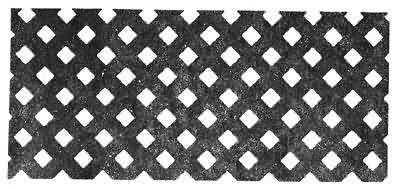Second, the characteristics of outlets
In the printing image processing, according to the method of screening, it is divided into AM outlets and FM outlets.
(1) ATM outlets ATM outlets are the most commonly used traditional outlets, and are also called AM outlets. This is usually done on a camera, using a screen or on an electronic color separation, through a dot generator, and electronic screening using a laser beam.
The screen has a glass screen and a contact screen, as shown in Figure 3-2. Since the mesh of the screen is arranged in an orderly manner, the distribution of the formed dots in the space is not only regular, but also the number of dots in a unit area is constant, the light and dark levels of the images on the manuscript depend on each dot The change in area is reproduced on the print. Corresponds to the deep part of the original ink printing.

Glass Screen

Contact Screen Figure 3-2
The product has a large dot area and accepts the most ink; corresponding to the shallow part of the original ink, the print dot area is small, and the amount of ink received is small, so that the depth of the image is reflected by the dot size.
1. Coverage ratio The coverage ratio of an outlet to an outlet is called the coverage of the outlet. It is usually expressed as a percentage. It is also called the outlet percentage. As shown in Figure 3-3.

Figure 3-3 Percentage of outlets
Generally, the dark tone of the continuous tone image, the range of the dot percentage is about 70% to 90%; the midtone portion, the dot variation range is about 40% to 60%; the tone tone, the dot variation range is about 10% to 30%. .
2. The angle between the centerline of the neighboring network points and the reference line is called the network line angle. The baseline can be horizontal or vertical. The commonly used network cable angle is shown in Figure 3-4.

Figure 3-4 Commonly used outlets
In 1995, China's printing industry standard stipulated that the vertical direction should be set to 0°. The angle difference is represented by "°", the angle is clockwise, and the entire circumference is divided into 360°, then the commonly used mesh angles are 0°, 15°, 75°, and 135°.
3. Within the unit length of the dot line number, the number of connection lines of the neighboring dot sites accommodated is called the dot line number. The commonly used dot lines are shown in Table 3-1.
The higher the number of outlets, the more outlets are accommodated per unit area and the better the reproducibility of tone. Fine prints are generally printed on paper with a high degree of smoothness and should be selected with high dot lines. If you use 150g/m2 coated paper to print the magazine cover, you can choose 60 to 70 lines/cm. Figure 3-5(a) shows the dot line number and tone reproduction. The number of outlets can be measured using a cable gauge. See Figure 3-5(b).


Figure 3-5 Network and tone reproduction, network cable gauge
Palisade fence is a type of security fence that consists of vertical steel or iron bars, called pales, that are attached to horizontal rails. The pales are typically pointed or angled at the top to deter climbing and provide a formidable barrier against intruders. Palisade fences are commonly used in industrial and commercial settings, as well as in high-security areas such as prisons and military bases. They are also popular for residential properties due to their durability and low maintenance requirements. Palisade fences come in a variety of heights, colors, and styles to suit different needs and preferences. They are an effective way to secure a property while also providing a visually appealing boundary.
Palisade security Fence,Picket Fence,Aluminium Palisade Fence,Steel Palisade Fence
HEBEI DOUDOU METAL FENCE PRODUCTS CO.,LTD. , https://www.doudoufencing.com